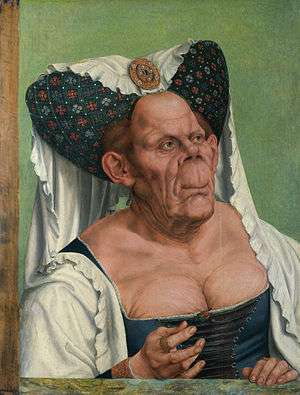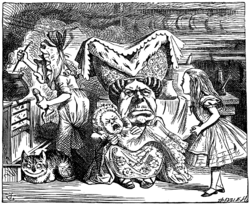The Ugly Duchess

The Ugly Duchess (also known as A Grotesque Old Woman) is a satirical portrait painted by the Flemish artist Quentin Matsys around 1513.
The painting is in oil on an oak panel, and measures 62.4 by 45.5 cm.[1] It shows a grotesque old woman with wrinkled skin and withered breasts. She wears the aristocratic horned headdress of her youth, out of fashion by the time of the painting, and holds in her right hand a red flower, then a symbol of engagement, indicating that she is trying to attract a suitor. However, it has been described as a bud that will 'likely never blossom'. The work is Matsys' best-known painting.[2]
The painting was long thought to have been derived from a putative lost work by Leonardo da Vinci, on the basis of its striking resemblance to two caricature drawings of heads commonly attributed to the Italian artist. However the caricatures are now thought to be based on the work of Matsys, who is known to have exchanged drawings with Leonardo.[3]
A possible literary influence is Erasmus's essay In Praise of Folly (1511), which satirizes women who "still play the coquette", "cannot tear themselves away from their mirrors" and "do not hesitate to exhibit their repulsive withered breasts".[2] The woman has been often identified as Margaret, Countess of Tyrol, claimed by her enemies to be ugly;[4] however, she had died 150 years earlier. In 2008 Michael Baum, emeritus professor of surgery at University College London, suggested that the sitter suffered from a rare form of Paget's disease, in which the victim's bones enlarge and become deformed.[3]
The painting is in the collection of the National Gallery in London, to which it was bequeathed by Jenny Louisa Roberta Blaker in 1947.[1] It was originally half of a diptych, with a Portrait of an Old Man,[5] in the Musée Jacquemart-André, Paris, which was lent to the National Gallery in 2008 for an exhibition in which the two paintings were hung side by side.[3]
The portrait is thought to be a source for John Tenniel's 1869 illustrations of the Duchess in Alice's Adventures in Wonderland.[6]
Gallery
|
References
- 1 2 "Quinten Massys An Old Woman (The Ugly Duchess)". The National Gallery. Retrieved 11 October 2012.
- 1 2 Grössinger, Christa (1997). Picturing women in late Medieval and Renaissance art. Manchester: Manchester University Press. p. 136. ISBN 0-7190-4109-0.
- 1 2 3 Brown, Mark (2008-10-11). "Solved: mystery of The Ugly Duchess - and the Da Vinci connection". The Guardian. Retrieved 2012-04-30.
- ↑ "SELL UGLIEST PORTRAIT.; Picture of Duchess Brings 880 Guineas at Christie's.". New York Times. 1920-01-24. Retrieved 2012-04-30.
- ↑ "More Than Just Pretty Faces; Here's looking at you". The Mail on Sunday. London. 2008-11-23.
- ↑ Gardner, Martin, ed. (1960). The Annotated Alice. New York: Bramhall House. p. 82.
External links
- "An Old Woman ('The Ugly Duchess')". The National Gallery, London. Retrieved 2012-04-30.

.jpg)

.jpg)